
Concept explainers
(a)
The value of
Answer to Problem 74QAP
The value of
Explanation of Solution
Given data:
Formula Used:
Newton's second law:
Calculation:

We'll use two different but related coordinate systems for the two blocks. For block
We can draw free-body diagrams and apply Newton's second law in component form for both blocks.
The tension acting on each block will be identical in magnitude.
Since block
Since, both blocks are at rest, which means the acceleration of each block is zero and we can calculate
.
Free-body diagram of
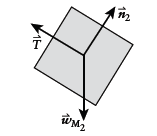
Newton's second law for
Free-body diagram of
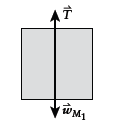
Conclusion:
For two blocks to be in equilibrium the value of
(b)
The magnitude of acceleration of two blocks if the system can move.
Answer to Problem 74QAP
The magnitude of acceleration of two blocks
Explanation of Solution
Given data:
Formula Used:
Newton's second law:
Calculation:

We'll use two different but related coordinate systems for the two blocks. For block
We can draw free-body diagrams and apply Newton's second law in component form for both blocks.
The tension acting on each block will be identical in magnitude.
Since block
Since,
The magnitude of the acceleration will be the same for each block because they are joined together with a string.
Free-body diagram of

Free-body diagram of
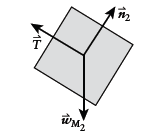
Newton's second law for
Conclusion:
If the system can move the magnitude of acceleration of two blocks is
(c)
The direction of
Answer to Problem 74QAP
The direction of
Explanation of Solution
Given data:
Formula Used:
Newton's second law:
Calculation:

We'll use two different but related coordinate systems for the two blocks. For block
We can draw free-body diagrams and apply Newton's second law in component form for both blocks.
The tension acting on each block will be identical in magnitude.
Since block
Since,
Free-body diagram of

Free-body diagram of
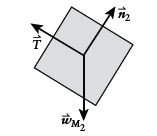
Newton's second law for
Since
Conclusion:
As we have value of
(d)
The distance to which block
Answer to Problem 74QAP
The distance to which block
Explanation of Solution
Given data:
Formula Used:
Newton's second law:
And
Calculation:

We'll use two different but related coordinate systems for the two blocks. For block
We can draw free-body diagrams and apply Newton's second law in component form for both blocks.
The tension acting on each block will be identical in magnitude.
Since block
Since,
If the acceleration is constant, we can use the constant acceleration equations to calculate how far
Free-body diagram of
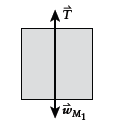
Free-body diagram of

Newton's second law for
By using the constant acceleration equations to calculate how far
Conclusion:
Thus in
Want to see more full solutions like this?
Chapter 4 Solutions
COLLEGE PHYSICS
- Consider mass m = 5kg placed on a ramp which makes an angle 40◦with respect to the x axis. The coefficient of static friction betweenramp and the mass is 0.8 and the coefficient kinetic friction betweenthe mass and the ramp is 0.7. (a) Does the mass move down the ramp? (b) Find the magnitude and the direction of the friction. (c) If we want to change the answer to part a) by adjusting the mass. Should we use a heavier mass or lighter mass, or it is just impossible to change the answer to a) by changing the mass. Ananswer with no explanation will recieve no credit.arrow_forwardAsaparrow_forwardb) A 20.0kg crate is at rest on a floor as shown. The coefficient of static friction between the crate and floor is 0.625 and the coefficient of kinetic friction is 0.525. Calculate the minimum horizontal force (F) required to make the crate start sliding. F The minimum horizontal force (F) required to make the crate slide is =arrow_forward
- Two crates connected by a rope lie on a horizontal surface. Crate A has mass mA, and crate B has mass mB. The coefficientof kinetic friction between each crate and the surface is mk. Thecrates are pulled to the right at constant velocity by a horizontal forceF vector. Draw one or more free-body diagrams to calculate the following interms of mA, mB, and mk: (a) the magnitude of F vector and (b) the tension inthe rope connecting the blocks.arrow_forwardA person stands on a platform and pulley system.The masses of the platform,person and pulleys are M,m u(mew) respectively.The rope is massless.Let the person pull up on the rope so that his acceration'a'upwards.(a)what is the tension on the rope? (b)what is the normal force between the person and the platform?arrow_forwardFy m +x P On the left a mass, 17.9 kg, is at rest. Force Pis acting on the mass in the (Fx) direction as shown. The coefficient of static friction between the mass and the surface is μ = 0.855. The coefficient of kinetic friction between the mass and the surface is µ = 0.565. What is the greatest force P that can be applied and the mass will remain at rest?arrow_forward
- (a) A mass of 2-Kg box hangs by an inextensible and massless string from a support. A horizontal force of 10 N acts on the box until it is in equilibrium as shown in the figure. Find the angle that the rope makes with the vertical. F= 10 N 2 kgarrow_forwardThe three blocks with weights as shown in the figure are placed on a 20o incline so that they are in contact with each other and at rest. Determine which, if any, of the blocks will move and the friction force acting under each. Assume that under blocks A and C, the coefficients of friction are fs = 0.50 and fk = 0.40 while under B they are fs = 0.30 and fk = 0.20arrow_forwardA freight train consists of two 8.00×104-kg enginesand 45 cars with average masses of 5.50×104kg . (a) What force must each engine exert backward on the track toaccelerate the train at a rate of 5.00×10–2 m/s2if the force of friction is 7.50×105 N , assuming the engines exertidentical forces? This is not a large frictional force for such amassive system. Rolling friction for trains is small, andconsequently trains are very energy-efficient transportationsystems. (b) What is the force in the coupling between the37th and 38th cars (this is the force each exerts on the other),assuming all cars have the same mass and that friction isevenly distributed among all of the cars and engines?arrow_forward
- Block A has a mass of 10 kg, and blocks B and c have masses of 5 kg each. Knowing that the blocks are initially at rest and that B moves through 3 m in 2 s, determine (a) the magnitude of the force P, (b) the tension in the cord AD. Neglect the masses of the pulleys and axle friction.arrow_forwardIn the overhead view of the figure, five forces pull on a box of massm 2.6 kg The force magnitudes are F-10N F 20N, F-3AN, F= 13N, and F 7.3N, and angle 0, is 34 Find the (a) x-component and (b) y-component of the box's acceleration, and also give the acceleration as (c) a magnitude and (d) an angle relative to the positive direction of the x axis. (Note that the angle will be negative if it is below the horizontal.) Units (a) Number Units (b) Number Units (c) Number Units (d) Number A 0 INarrow_forwardA 50 kg object is acted upon by two forces (in N) F, = - 107 +50 7 and F, = 10 7 +50 7 What is the magnitude of its acce.arrow_forward
 College PhysicsPhysicsISBN:9781305952300Author:Raymond A. Serway, Chris VuillePublisher:Cengage Learning
College PhysicsPhysicsISBN:9781305952300Author:Raymond A. Serway, Chris VuillePublisher:Cengage Learning University Physics (14th Edition)PhysicsISBN:9780133969290Author:Hugh D. Young, Roger A. FreedmanPublisher:PEARSON
University Physics (14th Edition)PhysicsISBN:9780133969290Author:Hugh D. Young, Roger A. FreedmanPublisher:PEARSON Introduction To Quantum MechanicsPhysicsISBN:9781107189638Author:Griffiths, David J., Schroeter, Darrell F.Publisher:Cambridge University Press
Introduction To Quantum MechanicsPhysicsISBN:9781107189638Author:Griffiths, David J., Schroeter, Darrell F.Publisher:Cambridge University Press Physics for Scientists and EngineersPhysicsISBN:9781337553278Author:Raymond A. Serway, John W. JewettPublisher:Cengage Learning
Physics for Scientists and EngineersPhysicsISBN:9781337553278Author:Raymond A. Serway, John W. JewettPublisher:Cengage Learning Lecture- Tutorials for Introductory AstronomyPhysicsISBN:9780321820464Author:Edward E. Prather, Tim P. Slater, Jeff P. Adams, Gina BrissendenPublisher:Addison-Wesley
Lecture- Tutorials for Introductory AstronomyPhysicsISBN:9780321820464Author:Edward E. Prather, Tim P. Slater, Jeff P. Adams, Gina BrissendenPublisher:Addison-Wesley College Physics: A Strategic Approach (4th Editio...PhysicsISBN:9780134609034Author:Randall D. Knight (Professor Emeritus), Brian Jones, Stuart FieldPublisher:PEARSON
College Physics: A Strategic Approach (4th Editio...PhysicsISBN:9780134609034Author:Randall D. Knight (Professor Emeritus), Brian Jones, Stuart FieldPublisher:PEARSON





